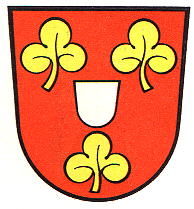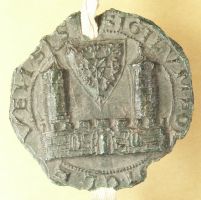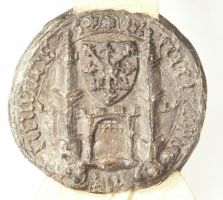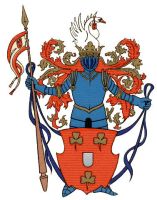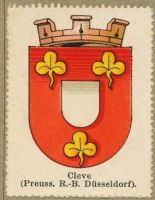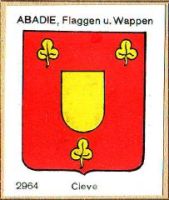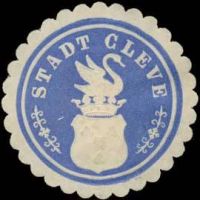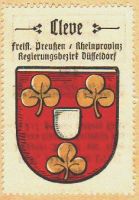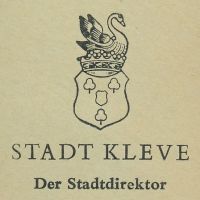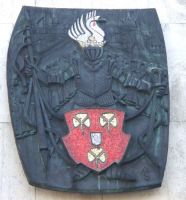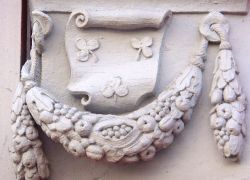Kleve (Kleve): Difference between revisions
Knorrepoes (talk | contribs) m (Text replacement - "|'''English''' ↵| {{blazon wanted}}↵" to "|'''English''' | blazon wanted ") |
Knorrepoes (talk | contribs) m (Text replacement - "===Image Gallery===" to "===Image gallery===") |
||
| (4 intermediate revisions by the same user not shown) | |||
| Line 4: | Line 4: | ||
|[[File:kleve.jpg|center|350 px|alt=Wappen von {{PAGENAME}}/Arms (crest) of {{PAGENAME}}]] | |[[File:kleve.jpg|center|350 px|alt=Wappen von {{PAGENAME}}/Arms (crest) of {{PAGENAME}}]] | ||
| | | | ||
<center>''' {{uc:{{PAGENAME}}}} '''</center><br> | |||
'''Country''' : Germany [[File:germany.jpg|60 px|right]]<br><br><br> | '''Country''' : Germany [[File:germany.jpg|60 px|right]]<br><br><br> | ||
'''State''' : [[Nordrhein-Westfalen]][[File:Nordrhei.jpg|60 px|right]]<br><br><br> | '''State''' : [[Nordrhein-Westfalen]][[File:Nordrhei.jpg|60 px|right]]<br><br><br> | ||
| Line 42: | Line 43: | ||
The present arms also appear in 14<sup>th</sup> century contra-seals. From the 16<sup>th</sup> century the colours of the arms are known. In the 17<sup>th</sup> century often a knight was used as supporter and as a crest on the helmet a swan, with the small city arms hanging on a rope around his neck, was used, see below. <br/> | The present arms also appear in 14<sup>th</sup> century contra-seals. From the 16<sup>th</sup> century the colours of the arms are known. In the 17<sup>th</sup> century often a knight was used as supporter and as a crest on the helmet a swan, with the small city arms hanging on a rope around his neck, was used, see below. <br/> | ||
===Image gallery=== | |||
<gallery widths=250px heights=200px perrow=0> | <gallery widths=250px heights=200px perrow=0> | ||
File:klevez2.jpg|alt=Siegel von Kleve/Seal of Kleve|City seal of Kleve from 25-01-1359 | File:klevez2.jpg|alt=Siegel von Kleve/Seal of Kleve|City seal of Kleve from 25-01-1359 | ||
| Line 55: | Line 57: | ||
</gallery> | </gallery> | ||
{{ | {{de}} | ||
{{ | {{media}} | ||
[[Civic Heraldry Literature - Germany|'''Literature''']]: Stadler, K. : Deutsche Wappen - Bundesrepublik Deutschland. Angelsachsen Verlag, 1964-1971, 8 volumes; Nagel, R. : Rheinisches Wappenbuch, Köln, 1986.; old image from Joachim Beeck, Meerbusch. | [[Civic Heraldry Literature - Germany|'''Literature''']]: Stadler, K. : Deutsche Wappen - Bundesrepublik Deutschland. Angelsachsen Verlag, 1964-1971, 8 volumes; Nagel, R. : Rheinisches Wappenbuch, Köln, 1986.; old image from Joachim Beeck, Meerbusch. | ||
Latest revision as of 08:26, 3 September 2023
|
Country : Germany State : Nordrhein-Westfalen District (Kreis) : Kleve Additions:
|
| German | In Rot ein silberner (Herzschild, begleitet von drei (2:1) goldenen Kleeblättern. |
| English | blazon wanted |
Origin/meaning
The present arms were officially granted in 1955 and did not change after the additions in 1969.
Kleve became a city in the 13th century. The arms show the old arms of the counts of Kleve, a red shield with a white escutcheon. The trefoils, or Kleeblättern, may be a canting symbol. The oldest great seals of the city show a castle or a city with between the towers the arms of the counts of Kleve (see the county arms).
The present arms also appear in 14th century contra-seals. From the 16th century the colours of the arms are known. In the 17th century often a knight was used as supporter and as a crest on the helmet a swan, with the small city arms hanging on a rope around his neck, was used, see below.
Image gallery
The arms in the Wappen-Sammlung (1900)
The arms in the Abadie albums
The arms by Hupp in the Kaffee Hag albums +/- 1925
The arms in the city (source)
The arms in the city (source)
This page is part of the German heraldry portal |
Heraldry of the World |
|
German heraldry:
|
Selected collector's items from Germany:
|
Contact and Support
Partners:
Your logo here ?
Contact us
© since 1995, Heraldry of the World, Ralf Hartemink 
Index of the site
Literature: Stadler, K. : Deutsche Wappen - Bundesrepublik Deutschland. Angelsachsen Verlag, 1964-1971, 8 volumes; Nagel, R. : Rheinisches Wappenbuch, Köln, 1986.; old image from Joachim Beeck, Meerbusch.
